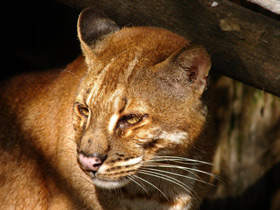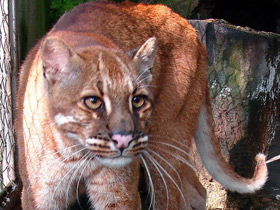The Asian golden cat (Catopuma temminckii)
The Asian golden cat (Catopuma temminckii) is a medium-sized wild cat native to the northeastern Indian subcontinent, Southeast Asia and China. It has been listed as Near Threatened on the IUCN Red List since 2008, and is threatened by poaching and habitat destruction, since Southeast Asian forests are undergoing the world's fastest regional deforestation.
The Asian golden cat's scientific name honours Coenraad Jacob Temminck. It is also called Temminck's cat and Asiatic golden cat.
Taxonomy
Felis temmincki was the scientific name used in 1827 by Nicholas Aylward Vigors and Thomas Horsfield who described a reddish brown cat skin from Sumatra. Felis moormensis proposed by Brian Houghton Hodgson in 1831 was a young male cat caught alive by Moormi hunters in Nepal. Felis tristis proposed by Alphonse Milne-Edwards in 1872 was a spotted Asian golden cat from China.
It was subordinated to the genus Catopuma proposed by Nikolai Severtzov in 1853. Two subspecies are recognised as valid since 2017:
- Catopuma temminckii temminckii occurs in Sumatra and the Malay Peninsula.
- Catopuma temminckii moormensis occurs from Nepal eastwards to Southeast Asia.
Habitat
The Asian golden cat (Catopuma temminckii, formerly in the genus Profelis and in Felis), also called Temminck's golden cat, is a species of carnivorous mammal in the family Felidae. It should not be confused with Felis silvestris ornata.
Catopuma temminckii is named after zoologist Conrad temminck, who first described the animal. This cat is common in Southeast Asia in Burma, Thailand, Laos, Vietnam, Nepal, southern China, northern India, as well as on some islands of Indonesia and Malaysia. Its usual habitat is deciduous forests in tropical and subtropical areas, but it can also be found at high altitudes, up to 2,000 metres above sea level. Open terrain is avoided by Catopuma temminckii.
Appearance
The size of this raptor can vary and is highly habitat-dependent. The largest specimens reach up to one metre in length, not including the tail, which can be up to half a metre. The fur of Catopuma temminckii is dense and of medium length and golden brown in colour, with dark and light stripes possibly present on the chest and head (the lower part of the body is usually much lighter than the back). Occasionally black and dark grey specimens occur. Catopuma temminckii weighs between 12 and 16 kg, depending on where it lives.
Nutrition and lifestyle
Catopuma temminckii feeds mainly on rodents (mice, rats), hares, small deer cubs, small wild pigs, etc. This Asian cat often feeds on birds, monkeys, small reptiles and large insects. Despite its relatively small size, it is a fairly strong animal, capable of killing prey larger than itself. It usually hunts on the ground and very rarely attacks from trees. Catopuma temminckii is nocturnal and walks mainly on the ground, although it can climb trees very well. This small carnivore is able to travel long distances in search of food.
Reproduction
Catopuma temminckii lives solitary, gathering only during the breeding season. Joint hunting has been recorded, which is rare for felines of the puma genus. By the time she gives birth, the female has established a den in natural tree cavities or on hillsides. A litter usually consists of 1 to 3 kittens, which are born 10 to 12 weeks after mating. The male stays nearby after the birth of the kittens, participating in the rearing of the kittens and providing food for the female.
Conservation status
Catopuma temminckii is legally protected in most of its range states. The species is listed as Near Threatened on the IUCN Red List.
Threats
The Asian golden cat inhabits some of the fastest developing countries in the world, where it is increasingly threatened by habitat destruction following deforestation, along with a declining ungulate prey base. In Sumatra, it has been reported killed in revenge for preying on poultry. In Southeast Asia and China, it is threatened by poaching for the illegal wildlife trade. This trade has the greatest potential to do maximum harm in minimal time.
Illegal wildlife trade
Asian golden cats are poached mainly for their fur. In Myanmar, 111 body parts from at least 110 individuals were observed in four markets surveyed between 1991 and 2006. Numbers were significantly greater than those of non-threatened species. Among the observed skins was one with rosettes. Three of the surveyed markets are situated on international borders with China and Thailand and cater to international buyers, although the Asian golden cat is completely protected under the country's national legislation. Effective implementation and enforcement of CITES is considered inadequate.
Conservation
Pardofelis temminckii is included in CITES Appendix I and fully protected over most of its range. Hunting is prohibited in Bangladesh, China, India, Indonesia, Malaysia, Myanmar, Nepal, Thailand and Vietnam. Hunting is regulated in Laos. No information about protection status is available from Cambodia. In Bhutan, it is protected only within the boundaries of protected areas.
In captivity
As of December 2008, there were 20 Asian golden cats in eight European zoos participating in the European Endangered Species Programme. The pair in the German Wuppertal Zoo successfully bred in 2007, and in July 2008, two siblings were born and mother-reared. In 2008, a female kitten was also born in the French Parc des Félins. The species is also kept in the Singapore Zoo. Apart from these, a few zoos in Southeast Asia and Australia also keep Asian golden cats.
Local names
In China, the Asian golden cat is thought to be a kind of leopard and is known as "rock cat" or "yellow leopard". Different colour phases have different names; those with black fur are called "inky leopards", and those with spotted coats are called "sesame leopards".
In some regions of Thailand, the Asian golden cat is called Seua fai (Thai: "fire tiger"). According to a regional legend, the burning of an Asian golden cat's fur drives tigers away. Eating the flesh is believed to have the same effect. The Karen people believe that carrying a single hair of the cat is sufficient. Many indigenous people believe the cat to be fierce, but in captivity it has been known to be docile and tranquil. In the south, it is called Kang kude and believed to be a fierce animal that can hurt or eat livestock and larger animals such as elephants.

















































